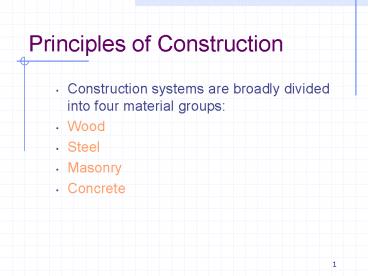Principles of Construction - PowerPoint PPT Presentation
1 / 24
Title:
Principles of Construction
Description:
The design of architectural structures directly involves the laws of physics. ... Lanai (la-ni) Porch, Veranda. 24. Principles of Construction. Modular Drawings ... – PowerPoint PPT presentation
Number of Views:186
Avg rating:3.0/5.0
Title: Principles of Construction
1
Principles of Construction
- Construction systems are broadly divided into
four material groups - Wood
- Steel
- Masonry
- Concrete
2
Principles of Construction
- Building are also divided into two types of
structures
Skeleton-frame
Bearing-wall
Open self-supporting framework
Solid walls for support
3
Principles of Construction
- The design of architectural structures directly
involves the laws of physics. - The design must support the load of the building
and the forces acting upon it. - The roof is supported by wall framework, interior
partitions, or columns. - Walls are supported by the ground and roof.
- The exterior walls are supported by the
foundation, which is supported by the footings. - The footings distribute the entire load of the
structure over the soil.
4
Principles of Construction
- A-Frame and Arc construction are supported
directly to the foundation.
5
Principles of Construction
- Structural Forces
- Compression (flattening affect)
- Tension (Pulling force)
- Shear (Sliding resistance)
- Torsion (Twisting force)
- See next slide
6
Principles of Construction
- Structural Forces
7
Principles of Construction
- Loads
- Live loads The weight of all moveable objects,
such as people, furniture, snow, rain, wind, ice,
etc. - Dead loads The weight of building material and
permanent objects such as the framing, walls,
brick, windows, roof and roof materials. - Building load is the total of the live and dead
loads.
8
Principles of Construction
- Loads
- Lateral (Horizontal) loads Wind, earthquakes.
- Roof loads are measured in PSF. The combined
load for wind and snow in the central/western
U.S. is 30 PSF, so our roof designs must be able
to support this live load.
9
Principles of Construction
- Loads
- This table shows some of the typical dead loads
for standard construction
10
Principles of Construction
- Loads
11
Principles of Construction
- Loads
- High pitch roofs withstand snow loads better than
wind loads because of the forces applied to them.
However, low pitch roofs withstand wind loads
better than snow loads.
12
Principles of Construction
- Resistance
- A structural member must always be equal to or
greater than the force applied. - To achieve good design the building loads,
material, size, shape, placement and spacing must
be carefully planned. - Strength of Materials
- The materials capacity to support loads by
resisting compression, tension, shear, and
torsion forces or stresses.
13
Principles of Construction
- Strength of Materials
- Deflection
- This is the stress result from both compression
and tension forces acting a structural member.
14
Principles of Construction
- Strength of Materials
- Shape
- Different shapes of a material influences its
ability to support loads. - Flat sheet of paper verses a folded sheet of
paper. - Corrugation
- Creases in sheet metal panels (Duct work)
15
Principles of Construction
- Strength of Materials
- Placement
- Most materials are somewhat flexible until
anchored into the structure. - Members with their widest dimension positioned
parallel to the load direction will resist
greater loads than members placed with their
smallest dimension in the load direction.
16
Principles of Construction
- Strength of Materials
- Spans and Spacing
- Spacing is the distance between parallel
structural members. - Span is the distance a member extends between
vertical supports. - Decreasing the span while using the same
structural members can increase the load-bearing
capacity of each member.
17
Principles of Construction
- Strength of Materials
- Cantilever
- A structural member that has only one end of a
horizontal structural member supported.
18
Principles of Construction
- Strength of Materials
- Cantilever
19
Principles of Construction
- Strength of Materials
- Equilibrium
- When the center supports equal dead loads on all
sides. - Roof overhangs, balconies, and decks are
structural features that are often cantilevered.
20
Principles of Construction
- Modular Construction
- Pre-constructed parts or components of a
building. - Modular components are designed to fit together
with precision. - Modular Components
- Pre-assembled wall sections, windows, and molded
bathrooms.
21
Principles of Construction
- Size Standardization
- Measurements divisible by the same base unit.
- A module of 3 includes material that measures
- 3, 6, 9, 12, etc.
- A module of 4 includes material that measures 4,
8, 12, 16, 20, etc. - This design involves all three dimensions that
must be standard. L X W X H - U.S. Standards allow all modules to fit on a 4 X
8 panel. Pg. 443
22
Principles of Construction
- Modular Construction
- Precut
- Materials that are cut to specific sizes and
assembled on site. - Prefabricated Holmes
- Major components (walls, decks, partitions) are
built and assembled at the factory - Electrical, plumbing, and heating systems finish
work is done on site
23
Principles of Construction
- Modular Construction
- Prebuilt Holmes
- Built totally at the factory.
- Includes HVAC, electrical, and plumbing
- Most states restrict widths on roadways to 14
- Two 14 sections of a 28 house can then be
shipped on the roadways and assembled onsite. - Prebuilt Modules
- Modules that can be combined to form a variety of
floor plan shapes - Lanai (la-ni)
- Porch, Veranda
24
Principles of Construction
- Modular Drawings
- Horizontal and vertical members are drawn to
align with grid lines - The total thicknesses of all of these walls must
be subtracted from the overall modular dimension
to obtain the correct inside dimension. - Locate dimensions (walls) on 16, 24, and 48.
- A good way to draw to modular units is to set the
CAD program to 4 SNAP increments.































